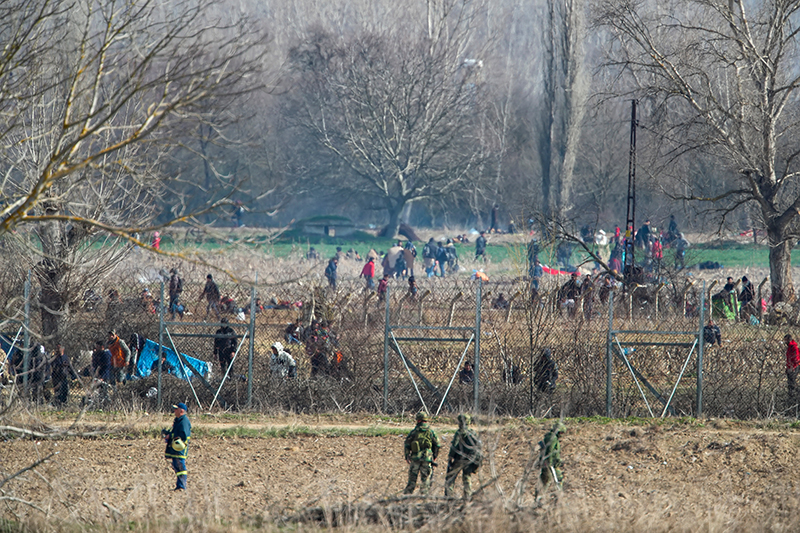Border Management in Transformation
In the 21st century, along with the process of globalization, an evolving security environment creates new dimensions of threats and challenges to security and stability of trans-national nature. This seeks for comprehensive, multidimensional, collective and well-coordinated responses. Precisely for that reason, the United Nations, the European Union (EU), Commonwealth of Independent States, and Organization for Security and Co-operation in Europe as well as other international organisations are able to really contribute in developing cooperative and coordinated responses to these threats by relying on its broad membership and profound expertise and experience.
Transnational threats such as cross-border organised crime, irregular migration including trafficking in human beings and people smuggling, as well as terrorism require comprehensive, multidimensional, collective and well-coordinated responses that are well integrated. The EU’s Integrated Border Management model provides an opportunity and extraordinary responsibility for each member state and also non-EU countries to choose among functioning practices and the most modern standards to control, survey and secure their external borders, taking into account political, security, socio-economic, environmental and cultural considerations.
The consistent application of the principle of legality and the implementation of effective control mechanisms enables each jurisdiction to enforce access for persons, goods and services through effective control and regulation. These activities have an immediate bearing on territory, personnel, communication, technology, equipment, training, collaboration at the intra-agency, inter-agency and international levels. The EU’s Integrated Border Management model represents a mature system of increased cooperation and coordination in the form of a comprehensive, multidimensional and collective response among a highly diverse set of countries with differing norms, interests and priorities.
This book looks into the processes of comprehensive changes and renewals of control mechanisms in the area of border security and management during the past 25 years after the fall of the Iron Curtain, and the immense challenges in nation-building in South-Eastern Europe after the collapse of former Yugoslavia in relation to strategic security management. The abolition of border controls within the EU’s Schengen area and simultaneous introduction of necessary compensatory measures was an additional topic.
In this work it has been possible to create a comprehensive synopsis of the extent to which the EU and international organisations were able to use their influence in the modernization and/or creation of state law enforcement agencies for ensuring effective border control and border security in line with the EU acquis communautaire and functioning practices developed.
During the last two decades various international conventions and concepts, national legislation, guidelines and documents were developed dealing with border security and management and to some extent with strategic security management. Therefore, this book focused on an all-encompassing approach and character related to border security and management and strategic security management.
The work aimed at an in-depth update to what extent these standards as well as the installation of new ‘filters’ have increased the quality of border checks of cross-border traffic. Furthermore, common methods of cross-border cooperation in the fields of researching and combating of offenses related to transnational threats as above are explored and analysed and corresponding conclusions developed to improve the fight against cross-border crime.
A modern, cost-benefit-oriented and effective border management system should ensure both open borders as well as a maximum of security and peace and thereby facilitating free travel and free trade, and services to ensure most important prerequisites for economic growth and a simultaneous fight against poverty.
In parallel, potential hazards related to transnational threats and cross-border organized crime must be clearly identified and fought consistently through trustful partnership and transparent information exchange. This level of cooperation in cross-border context is a very important cornerstone of the concept of Integrated Border Management, which ensures enhanced coordination and cooperation between all relevant authorities and organizations in the fields of border surveillance, border control, cross-border cooperation and information exchange in achieving the jointly defined objectives in terms of open but secure borders.
As one of the main goals of the EU’s Integrated Border Management model to open, yet secure borders is therefore a significant increase of cooperation between all the actors involved, both at national and international level. This applies within the respective border law enforcement authorities (i.e. intra-agency cooperation), as well as between other involved government departments and agencies of a country (i.e. inter-agency cooperation) and also across borders in bilateral and multi-lateral context (i.e. international cooperation).
Consequently, two crucial questions were addressed:
- Which transnational threats and cross-border crime forms applies it with the system of Integrated Border Management to ward off and fight?
- Which instruments and mechanisms should be improved, or to be developed new ones in order to ensure effective and efficient Integrated Border Management?
The process to develop a new awareness of the dimensions of the major challenges is to clarify, which standards and processes the international community needs to develop in order to combat the complexity of these potential threats effectively.
The EU’s political decision makers and opinion leaders are convinced that the Integrated Border Management model is, therefore, without an alternative to more effectively prevent transnational threats in general and, in particular, to combat terrorism, transnational organized crime and its operating criminal syndicates and their criminal activities. For many years now, the safeguarding, control, and surveillance of the EU’s member state borders is not restricted to its national territory itself anymore and other states follow suit. The EU’s Integrated Border Management model is suitable for replication in other countries and regions based on functioning practices developed.
Far from a contradiction, the EU’s IBM shows that open yet secure borders are indeed possible.
An extract from a new book ‘Border Management in Transformation – Transnational Threats and Security Policies of European States’
by Johann Wagner
Border Management in Transformation is available from www.springerprofessional.de/en/border-management-in-transformation/18630122



